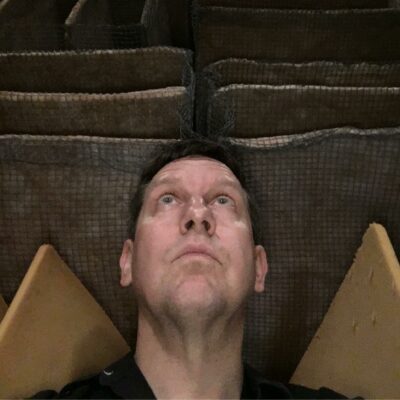
Kazys Varnelis is a synthesist: an artist and historian, working at the intersection of art, technology, architecture, sound, and the environment. Holding a Ph.D. in the History of Architecture and Urban Development from Cornell University, he taught for twenty-five years at schools of architecture, served as director of the Network Architecture Lab and is co-founder of AUDC. He is also a passionate advocate of the environment and rewilding, currently serving as vice president for membership, chair of advocacy and legislation, and board member at the Native Plant Society of New Jersey.
His books include Blue Monday: Absurd Realities and Natural Histories (with Robert Sumrell as AUDC, 2007), the Infrastructural City. Networked Ecologies in Los Angeles, Networked Publics and the Philip Johnson Tapes (all in 2008). His artwork has been displayed in shows at High Desert Test Sites, the New Museum, and the Museum of Modern Art and he was the subject of Detachment, a major standalone exhibition at the Contemporary Art Centre in Vilnius, Lithuania in 2016.
Born in Chicago in 1967, he is the son of Lithuanian geometric abstractionist Kazys Varnelis [1917-] and grandson of Kazys Varnelis, the noted Samogitian folk artist [1867-1945]. Growing up in the city of Ludwig Mies van der Rohe, he became attuned to architecture at an early age. When his family moved to the Berkshires, he encountered Fluxus, meeting George Maciunas and getting to know the movement through noted Fluxus collector Jean Brown who became close friends with his mother.
He received his Ph.D. in the History of Architecture and Urban Development from Cornell University in 1994, where he completed his dissertation on the role of the spectacle in the production of form and persona in the architecture of the 1970s. In the course of his dissertation, he uncovered how architect Philip Johnson accompanied the Nazi government on the Blitzkreig into Poland, his attempts to create a fascist movement in the United States, work for Father Charles Coughlin’s notorious Social Justice, and the postwar effort to rehabilitate him (read more here).
From 1996 to 2003 he taught at the Southern California Institute of Architecture where he was coordinator of the program in the History and Theory of Architecture and Cities. In 2004, he was awarded a year-long appointment as senior researcher at the Annenberg Center for Communications at the University of Southern California where he examined the impact of telecommunications and digital technology on urbanism and architecture and directed a team of thirteen scholars looking at how new and maturing networking technologies are reconfiguring the ways by which we interact with content, media sources, other individuals and groups, and the world that surrounds us. The result was the book Networked Publics.
In 2004 he became a founding member of the faculty of the School of Architecture at the University of Limerick, Ireland where he taught until 2017. From 2006 to 2015 he ran the Network Architecture Lab and was a full-time member of the faculty of the Graduate School of Architecture, Planning, and Preservation at Columbia University. He has also taught in the Environmental Design program at the Art Center College of Design in Pasadena, the Public Art Studies program at the University of Southern California, the Department of Architecture at the Massachusetts Institute of Technology as well as in the Department of Architecture at the University of Pennsylvania.
He has lectured internationally at schools such as Harvard, Yale, MIT, UCLA, TU-Delft, Taliesin West,IUAV and at venues such as the Frieze Art Fair in London, Transmediale in Berlin, the Digital Life Design Conference in Munich, the Architectural League, the Van Alen Institute, the Center for Land Use Interpretation, the Open Society Fund, and the Glass House.
He has published in journals such as A+U, Praxis, Log, Perspecta, Volume, An Architektur, Junk Jet, and Cabinet and has served on the boards of numerous scholarly journals such as Thresholds, the Journal of Architectural Education, and Kulturos Barai. He served as media review editor for the Journal of the Society of Architectural Historians.
As former President of the Los Angeles Forum for Architecture and Urban Design, he received the Educator of the Year Award from the Los Angeles Institute of the American Institute of Architects. He was a member of the National Board of DOCOMOMO-US from 2004 to 2012 and has served on the Board of Directors of the Native Plant Society of New Jersey since 2021.
“It is illegal to call me an architect.”- Kazys Varnelis